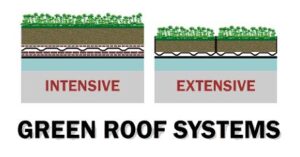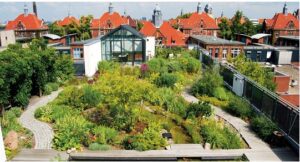ROOF TOP GARDENING – PEOPLE PLANT PROFIT
Roof Top Gardening
18th January 2022

To understand the premise for rooftop gardens apart from its aesthetic look, we must understand what heat island effect is.
An urban heat island is an urban area or metropolitan area that is significantly warmer than its surrounding rural areas due to human activities. The temperature difference is usually larger at night than during the day and is most apparent when winds are weak.
Now-a-days heat islands, especially in urban arears are very common. It is mainly created by buildings and pavement that absorb sunlight during the day and release the energy during the nights, which cause higher temperatures around urban arears.
To overcome the heat island effect, people use high albedo (light coloured) materials; this simply reflects the radiant to other materials that can absorb it and release it in the evenings.
Further, replacing black asphalt and shingles with plants can lower the surrounding air temperature, filter dirty storm water, and reduce a building’s energy use. Thus, giving rise to the concept of green rooftops.
Roof gardening can reduce the amount and improve the quality of stormwater runoff from a building site. The plants and soils filter the stormwater, which helps to clean pollutants that can negatively affect the natural surroundings. So, it naturally cleans water without the need of special infiltration basins or equipment.
There are several things to be consider while designing the roof gardening and the main item is structural load.


Extensive green roofs are very thin layer of soil or other planting medium with shallow-root plants. In this type of system, the structural load is less.
For extensive system plants like sedum, moss, and grasses are preferred. The soil is usually not more than 2″ to 5″ deep.
For this a try system is more helpful, which helps as a barrier to excessive growth, protects the roof membrane, and also interlocks the entire system together to prevent wind damage.
The weight of this system is nearly 4.5 to 12 kgs dry weight.

Intensive green roofs are deep layer of soil or other planting medium with deep-root plants. In this type of system, the structural load is more.
For intensive system plants like sedum, moss, grass, large shrubs, trees preferred. The soil is usually not more than 8″ to 30″+ deep.
The weight of this system is nearly 18 to 45 kgs dry weight.
These types of systems improve the life of the membrane because it is completely covered by planting and isn’t exposed to the sun’s harsh UV rays.
Green roofs can also reduce energy costs for a building by acting as another layer of insulation between inside and outside of the roof. This we can see mainly in intensive system where there is a thicker and more consistent layer of soil.
RECOMMENDED

Jali, a traditional architectural element renowned for its beauty and functionality, has evolved...

Green audits are essential tools that provide a comprehensive assessment of an organization's environmental...

Daylighting is a strategic element in sustainable architecture, essential for reducing energy consumption and enhancing...